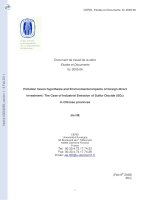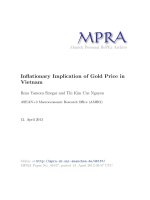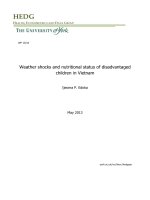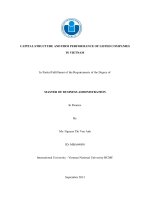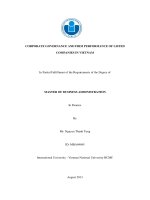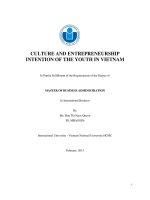AGGLOMERATION ECONOMIES AND LOCATION CHOICES OF FOREIGN INVESTORS IN VIETNAM
Bạn đang xem bản rút gọn của tài liệu. Xem và tải ngay bản đầy đủ của tài liệu tại đây (599.19 KB, 15 trang )
Paper to be presented at the 25th Celebration Conference 2008
on
ENTREPRENEURSHIP AND INNOVATION - ORGANIZATIONS, INSTITUTIONS,
SYSTEMS AND REGIONS
Copenhagen, CBS, Denmark, June 17 - 20, 2008
AGGLOMERATION ECONOMIES AND LOCATION CHOICES OF FOREIGN
INVESTORS IN VIETNAM
Binh Thi Thanh Dinh
University of Trento, Italy
Group 1: Dinh Thi Tam
Huynh Hien Hai
Tran Cam Linh
Tran Hoang Vu
Abstract
• This paper studies the effects of agglomeration economies on the location
choices by foreign firms in Vietnam.
• Data: By using a large dataset that provides detailed information about
individual firms, the study examines the location choices by 568 newly created
foreign firms in 2005 in about 150 different 4-digit industries. (GSO, VietNam)
• Model: the negative binomial regression model and the conditional logit
model
• The study shows that foreign investors are not only likely to locate near other
foreign firms but also prefer to locate near foreign firms in the same industries
and from the same countries of origin.
• The paper demonstrates that agglomeration economies do not spread across
the provincial borders in Vietnam and the locations of Vietnamese firms have
no role on the location decisions by foreign investors in the same industries.
1. Introduction
• The “factor endowment” theory, which was developed
from Ricardo’s theory of comparative advantage by
Heckscher and Ohlin (Krugman and Maurice, 1997),
• Theories of economic geography suggest that firms in
the same industries may be drawn to a particular
location in order to benefit from positive externalities or
agglomeration effects.
• The theory of agglomeration economies was introduced
by Marshall (1920).
• Krugman (1991) and Saxenian (1994) construct formal
models to analyze and extend the concepts.
Few empirical studies on agglomeration
effects
There have been few empirical studies on
agglomeration effects: Head, Ries and Swenson
(1995), Guimaraes and Figueiredo (2000) and
Crozet, Mayer and Mucchielli (2004).
There are also studies that do not support the
existence of agglomeration effects: Shave and
Flyer (2000); Empirically, Baum and Mezias
(1992) and Baun and Haveman (1997).
2. An overview of regional economies and the stylized facts of foreign direct investment (FDI)
patterns in Vietnam
Regional economies
Designed by Mapinfo 10.5
The FDI
patterns
investors from Japan or China
were likely to locate in some
provinces of the Red River
Delta region such as the cities
of Hanoi and Hai Phong (GSO,
2005).
investors from Taiwan or the US
preferred to concentrate in some
provinces of the Southeast region
such as Ho Chi Minh City, and Binh
Duong and Da Nang provinces
(GSO, 2005)
Designed by Mapinfo 10.5
Theories of localization
• Industry localization is defined as “the geographic concentration of particular industries” (Head et al., 1995).
• Firms contribute to the externalities and also benefit from the externalities (Shave and Flyer, 2000).
• Marshall (1920): (i) technological spillovers among producers, (ii) localized industry allows a pooled market for workers with
specialized skills that benefits both workers and firms, and (iii) localized industry creates a pool of specialized intermediate
inputs for an industry in greater variety and at lower cost, localized industry allows a pooled market for workers with
specialized skills to benefit both workers and firms.
• According to Krugman (1991), the concept of technological spillovers is quite vague and general but it is the most frequently
mentioned as a source of agglomeration effects. He argues that the combination of scale economies and transportation costs
will motivate the users and suppliers of intermediate inputs to cluster near each other.
• Head et al., 1995: For foreign companies, the spillovers of information can be the flows of experience-based knowledge
about how to operate efficiently in the host countries.
• Hypothesis 1: the greater the number of foreign firms
already established in a province, the more likely new
foreign investors are to invest in that province.
• Hypothesis 2: the greater the number of domestic firms
and foreign firms in a specific industry already located in a
province, the more likely new foreign investors in that
industry are to locate in that province.
• Hypothesis 3: the greater the number of foreign firms
from a specific country already located in a province, the
more likely new foreign investors from that country are to
locate in that province.
Data
•
Ho Chi Minh City, Binh Duong and
Da Nang provinces (the Southeast
region), and Hanoi (the Red River
Delta region): accounted for 78.5
per cent of the 568 new foreign
firms in 2005.
•
30 out of the 64 provinces in
Vietnam had no new foreign
investors in 2005.
Methodology and Empirical Results
1. Agglomeration effects on location choices by foreign firms in Vietnam, using the negative
binomial regression model.
•. The dependent variables are the number of newly created foreign firms and the number of
new foreign firms by province that operate in the manufacturing sector.
•. Agglomeration variables: In order to examine Hypothesis 1, the cumulative number of
foreign firms by province up to 2004 is used as a proxy; To examine Hypothesis 2, the
cumulative number of foreign and Vietnamese firms in the manufacturing sector at
provincial level up to 2004 is used as proxies.
•. Control variables: such as the size of the provincial economy, the size of the provincial
market, infrastructure, human resources, and geographical location.
new foreign firms are
more likely to locate in
provinces with greater
numbers of already
existing foreign firms.
foreign firms in the
same industries are
likely to locate near
each other
suggests that the
locations
of
Vietnamese firms do
not
influence
the
location decisions by
foreign firms in
the same industries.
ignores unobserved
heterogeneity among
observations
2. Agglomeration effects on location choices by foreign firms in
Vietnam, using the conditional logit model
Dependent variable : The dependent variable is the province chosen by
each foreign firm that was newly created in 2005.
Agglomeration variables:
- Foreign-specific agglomeration: the cumulative number of foreign firms
by province up to 2004 (forfirm04) is used as a proxy.
- Industry-specific agglomeration: vnfirm4dgsic, same4dgsic, border4dgsic.
- Country-specific agglomeration: the cumulative number of foreign firms
from the same countries of origin by province up to 2004 (samecountry)
is used as a proxy.
Control variables: the same control variables of the negative binomial
regression model are used.
Column 1 reveals that foreign firms are likely to
locate in provinces where there already existed a
relatively large number of both foreign firms and
Vietnamese firms in the same 4-digit industries.
In Columns 2 and 3: same4dgsic, border4dgsic are
added to the regression model. The locations of
foreign investments are influenced by the
previous location choices by other foreign firms in
the same industries.
In Column 3: samecountry is added. The positive
and statistically significant coefficient of the
variable samecountry, the cumulative number of
foreign firms from the same country of origin,
indicates that foreign firms benefit from locating
near firms from the same countries of origin.
Samecountry var < same4dgsic var: suggests that
the benefits foreign firms gain from industryspecific agglomerations are higher than from
country-specific agglomerations.
Agglomeration economies do not cross the
borders of the provinces in Vietnam.
These results indicate that the characteristics of
the provinces are important determinants in
attracting foreign investors.
Conclusions
• This paper argues that agglomeration externalities influence the location
decisions by foreign firms.
• The empirical results show that the location choices by new foreign firms in
Vietnam are affected by the locations of the prior foreign investments in
general and by those of firms in the same industries and from the same
countries of origin in particular.
• The study finds that the geographical distribution of Vietnamese firms has no
effect on the location choices by foreign investors.
• The paper also does not find any evidence of agglomeration externalities
across the boundaries of provinces.
• The empirical findings on agglomeration economies may be particularly
useful for provincial authorities in designing policies to attract more foreign
direct investment.
• This study has two limitations: The first is that the empirical results refer to
only 2005. The second limitation is that the paper has studied the location
decisions by foreign firms only at the provincial level.
XIN CHÂN THÀNH CẢM ƠN THẦY VÀ CÁC
ANH CHỊ ĐÃ THEO DÕI!


